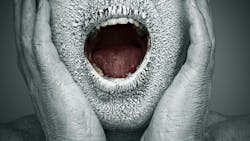Radiation-induced xerostomia treatment: Pilot clinical trial shows promise
If you practice in the dental field for any length of time, you’ll encounter xerostomia and its detrimental effects on the oral cavity. Numerous medical conditions, medications, and aging can cause varying degrees of dry mouth.
Radiation treatments to the head and neck contribute significantly to xerostomia in oropharyngeal cancer patients. Here I discuss a pilot clinical trial that was conducted at the University of Wisconsin Madison (UW) to help treat radiation-induced xerostomia.
Oropharyngeal cancer statistics and causes
The American Cancer Society estimates there will be 58,450 new cases and 12,230 deaths from cancer of the oral cavity and pharynx in the US in 2024.1 In addition, there’s been a shift in causal factors. HPV-related incidence of oropharyngeal cancers is steadily increasing, while cases attributed to other causes, such as alcohol and tobacco use, are decreasing.2 An estimated three-quarters of all oropharyngeal cancers are caused by chronic HPV infection, specifically HPV type 16.3
Oropharyngeal cancer treatment
Head and neck cancer treatment includes surgery, radiation therapy, chemotherpy, targeted therapy, immonotherapy, or a combination of treatments. Individual treatment plans depend on many factors, including the location of the tumor, the stage of the cancer, and the patient’s age and general health status.4
Research has shown that patients with HPV-positive oropharyngeal tumors have a much better prognosis and higher chance of complete cure than those with HPV-negative tumors following the same treatment plan.5 Patients who undergo head and neck radiation treatment often experience damage to their salivary glands. This damage leads to xerostomia, which may impair ability to swallow and speak, diminish taste, and increase dental caries rates.6
Patients frequently rely on their dental providers for recommendations to treat xerostomia. Staying hydrated, avoiding caffeine and alcohol, and using salivary substitutes such as Biotene mouth rinse are common recommendations. Medications such as Pilocarpine may also be prescribed. A pilot clinical trial conducted at UW shows promise to add further treatment options for patients suffering with radiotherapy-induced xerostomia.
The pilot study explained
Dr. Randall Kimple, a radiation oncologist at UW Health Carbone Cancer Center who treats head and neck cancer patients, is working to address the xerostomia his patients experience as a side effect of cancer treatments. Dr. Kimple is the principal investigator on a new phase I clinical trial evaluating a cell therapy treatment developed at UW to increase saliva production.
In a pilot study, Dr. Kimple partnered with Dr. Jacques Galipeau, director of the Program for Advanced Cell Therapy (PACT) at UW, to explore use of stromal cells as a regenerative therapy for damaged salivary glands. In their approach, stromal cells, which can form connective tissue, were taken from a patient’s bone marrow, treated with interferon gamma, and injected into the patient’s salivary gland to rebuild function.7 Following the procedure, patients returned for five visits spanning two years. At each visit, a patient’s submandibular saliva was collected, and production volumes were compared to those of previous visits as well as the patient’s baseline production.
Results of the pilot study are promising as participants showed remarkably improved natural saliva production. My dad was one of the pilot study participants and personally had a dramatic increase in his salivary production and quality of life. Dr. Kimple and his collaborators have since begun to expand their work in an FDA-approved phase I clinical trial, with projected completion in 2026.7
In dentistry, as in general health care, research supports the foundation of our practice. We base our recommendations to patients on evidence from clinical studies that eventually become standards of care. Imagine a future where, after overcoming cancer, a few injections into the salivary glands may help a patient live with normal salivary function for the remainder of their life. Only time will tell, but I for one am excited to see the possibilities unfold.
References
1. Cancer facts and figures 2024. Cancer. 2024. Accessed July 24, 2024. https://www.cancer.org/content/dam/cancer-org/research/cancer-facts-and-statistics/annual-cancer-facts-and-figures/2024/2024-cancer-facts-and-figures-acs.pdf
2. Chaturvedi AK, Engels EA, Pfeiffer RM, et al. Human papillomavirus and rising oropharyngeal cancer incidence in the United States. J Clin Onc. 2011;29(32):4294–4301. https://doi.org/10.1200/JCO.2011.36.4596
3. Senkomago V, Henley SJ, Thomas CC, Mix JM, Markowitz LE, Saraiya M. Human papillomavirus-cttributable Cancers–United States, 2012–2016. MMWR Morb Mortal Wkly Rep. 2019;68:724-758. doi:10.15585/mmwr.mm6833a3
4. Head and neck cancers. Cancer. Reviewed May 25, 2001. Accessed July 24, 2024. https://www.cancer.gov/types/head-and-neck/head-neck-fact-sheet
5. Ang KK, Harris J, Wheeler R, et al. Human papillomavirus and survival of patients with oropharyngeal cancer. New Eng J Med. 2010;363(1):24-35. doi:10.1056/NEJMoa0912217
6. Mesenchymal stem cells for the treatment of radiation-induced xerostomia in patients head and neck cancer. Cancer. Accessed July 24, 2024. https://www.cancer.gov/research/participate/clinical-trials-search/v?id=NCI-2021-00070
7. Testing a promising treatment for radiation-induced dry mouth. UW Health. June 15, 2023. Accessed July 24, 2024. https://www.uwhealth.org/news/testing-a-promising-treatment-for-radiation-induced-dry-mouth
About the Author
Kayla Marks, BA, RDH, CDA
Kayla Marks, BA, RDH, CDA, is a licensed dental hygienist and certified dental assistant with 25-plus years of experience as an oral health-care provider in both general dentistry and periodontics. She’s a full-time faculty member of the dental hygiene and dental assisting programs at Blackhawk Technical College in Janesville, Wisconsin. She most recently completed her career and technical education leadership certificate from the University of Wisconsin-Stout.
